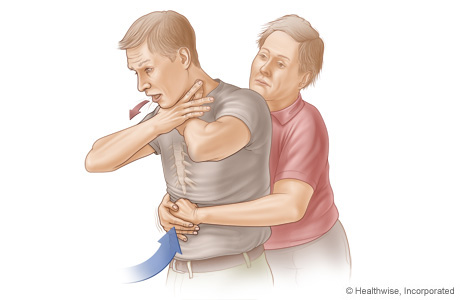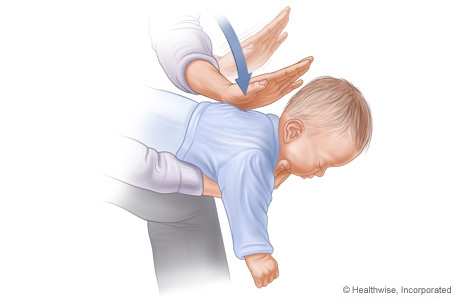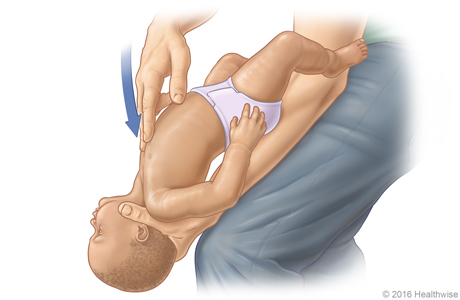Choking Rescue Procedure: Heimlich Maneuver
Overview
Choking is usually caused by food or an object stuck in the windpipe. For tips to avoid choking, see preventing choking.
A person who is choking cannot talk, cough, or breathe, and may turn gray or blue. The Heimlich maneuver can help get the food or object out.
WARNING: Do not try the Heimlich maneuver unless you are sure the person is choking.
Adult or Child Older Than 1 Year
If the person can cough or make sounds, let him or her cough to try to get the object out. If you are worried about the person’s breathing, call 911.
If the person can’t breathe, cough, or make sounds, then:
- Stand or kneel behind the person and wrap your arms around his or her waist. If the person is standing, place one of your legs between his or her legs so you can support the person if he or she faints.
- Make a fist with one hand. Place the thumb side of your fist against the person’s belly, just above the belly button but well below the breastbone. See picture A.
- Grasp your fist with the other hand. Give a quick upward thrust into the belly. This may cause the object to pop out. You may need to use more force for a large person and less for a child or small adult. See picture B.
- Repeat thrusts until the object pops out or the person faints.

Picture A

Picture B
Person Faints
Call 911 or other emergency services if the person faints. Then:
- Start CPR (cardiopulmonary resuscitation) if you know how. See CPR in the topic Dealing With Emergencies.
- If you do rescue breaths, look for an object in the mouth or throat each time the airway is opened during CPR. If you see an object, remove it.
- Do not do any more Heimlich thrusts.
- Keep doing CPR until the person is breathing on his or her own or until help arrives.
Choking While Alone
If you choke while you are alone, use your fists to do thrusts on yourself. Or lean over the back of a chair and press hard to pop out the object.
Baby (Younger Than 1 Year)
If the baby can cough or make sounds, let him or her cough to try to get the object out. If you are worried about the baby’s breathing, call 911.
If a baby can’t breathe, cough, or make sounds, then:
- Put the baby facedown on your forearm so the baby’s head is lower than his or her chest.
- Support the baby’s head in your palm, against your thigh. Don’t cover the baby’s mouth or twist his or her neck.
- Use the heel of one hand to give up to 5 back slaps between the baby’s shoulder blades. See picture C.
- If the object does not pop out, support the baby’s head and turn him or her faceup on your thigh. Keep the baby’s head lower than his or her body.
- Place 2 or 3 fingers just below the nipple line on the baby’s breastbone and give 5 quick chest thrusts (same position as chest compressions in CPR for a baby). See picture D.
- Keep giving 5 back slaps and 5 chest thrusts until the object comes out or the baby faints.
- If the baby faints, call 911 (if you haven’t called already). Then:
- Do not do any more back slaps or chest thrusts.
- Start CPR. If you do rescue breaths, look for an object in the mouth or throat each time the airway is opened during CPR. If you see the object, take it out. But if you can’t see the object, don’t stick your finger down the baby’s throat to feel for it.
- Keep doing CPR until the baby is breathing on his or her own or until help arrives.

Picture C

Picture D
Current as of: June 26, 2019
Author: Healthwise Staff
Medical Review:William H. Blahd, Jr., MD, FACEP – Emergency Medicine & Adam Husney, MD – Family Medicine & Kathleen Romito, MD – Family Medicine & David Messenger, BSc, MD, FRCPC, FCCP – Emergency Medicine, Critical Care Medicine
This information does not replace the advice of a doctor. Healthwise, Incorporated, disclaims any warranty or liability for your use of this information. Your use of this information means that you agree to the Terms of Use. Learn how we develop our content.

